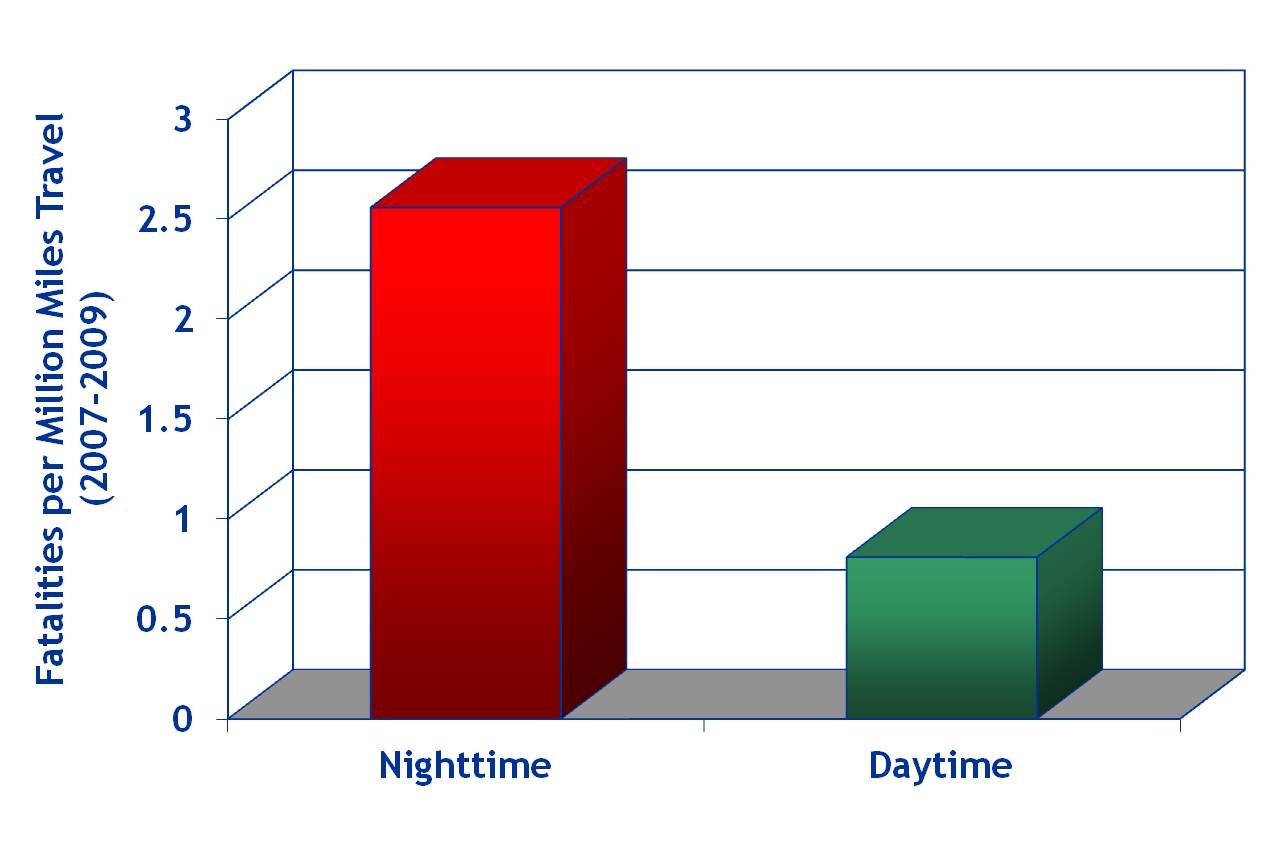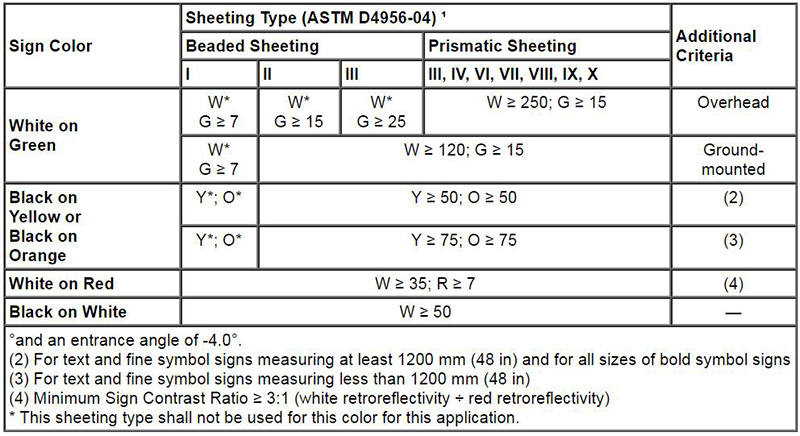Night Travel and Crashes


Centers around a method to maintain retroreflectivity

The numbers are also in the MUTCD (this was somewhat controversial)
The chart is a little complex, so Example 1: a curve warning sign
black on yellow
*Type I (eng grade) should not be used
Any other type okay and should have a yellow retro level of 50 or 75
(2) Since curve is not text or fine symbol, should meet 50
Black not retroreflective, so don't have to measure it.
Example 2: Stop Sign
Any type sheeting meets initially
Both white and red have to meet retro levels: White≥35, Red≥7
(3) Need contrast ratio ≥ 3:1 (eg red=20, white must ≥60)
Methods to Maintain Retro
Visual Nighttime Inspection
Calibration Signs
Comparison Panels
Consistent Parameters
Measured Sign Retro
Expected Sign Life
Blanket Replacement
Control Signs
Future Method Based On Engineering Study
Combination Of Any
Methods Intro
So those are the numbers you need to meet, but remember the requirement is to have a method that maintains those minimums.
The rule provided much versatility – many methods are available
Research details are in the “Methods Report” on-line at FHWA nighttime visibility site.
Each method has some advantages and disadvantages that should be considered. Combining methods can help minimize the concerns/disadvantages.
Keep in mind the goal is to have visible signs that at least meet the needs of drivers during nighttime.
MUTCD Language
Section 2A.08 Maintaining Minimum Retroreflectivity
“Support:
Compliance… is achieved by having a method in place and using the method to maintain the minimum levels established in Table 2A-3. Provided that… a method is being used, an agency would be in compliance… even if there are some individual signs that do not meet the… levels at a particular point in time.
This support statement helps to limit an agency's liability: compliance is by implementing a maintenance method, even if some signs do not meet levels at a particular time.
It is not meant as an easy out: the maintenance method must be designed to maintain the minimum requirements fro sign retroreflectivity.
Exempt Signs
Parking/Standing/Stopping
Walking/Hitchhiking
Adopt-A-Highway
Blue or Brown Backgrounds
Exclusive Use of Bikes or Peds
Note: Must still meet other requirements in MUTCD (inspections, retroreflective, etc,)
Several signs are exempted. The research for blue and brown retroreflectivity has been completed since the standards were adopted. Report FHWA -HRT-08-029 provides minimum recommended retroreflectivity levels for blue and brown signs.
Compliance Date Final Rule
Federal RegisterMay 14, 2012
Eliminated 46 items
Revised 4 others items
Safety related compliance dates maintained (8)
Revision #2 of the 2009 MUTCD
The final rule also adds a new Option statement exempting existing historic street name signs within a locally identified historic district from the Standards and Guidance of Section 2D.43 regarding street sign color, letter size, and other design features, including retroreflectivity.
2009 MUTCD Revision 1 deals with change in Engineering Judgment definition – not part of this presentation
Updated Sign Retroreflectivity Compliance Dates
January 2012 June 2014 – Implementation and continued use of an assessment or management method that is designed to maintain traffic regulatory and warning sign retroreflectivity at or above the established minimum levels
January 2015 - Replace identified regulatory, warning, ground-mounted guide signs (except street-name)
January 2018 - Replace identified street name & overhead guide signs
The dates for having a method selected and in use was extended 2.5 years. Guide signs have been removed from the first compliance dates…however, they are to be added to an agency's management or assessment method as resources allow.
The compliance dates for signs below the minimums have been removed …. without these “target” compliance dates, each agency must prioritize and justify their schedule of sign replacement. Signs identified through an agency's maintenance method as being below the minimum established retroreflectivity levels have exhausted their useful service life and need to be replaced because they do not meet the needed function of being adequately visible at night.
Agencies are expected to prioritize replacement of wornout signs based on engineering considerations, similar to other traffic control devices.
Why were guide signs removed from compliance dates?
Regulatory and warning signs constitute the highest priority for assessing retro of existing signs
Including guide signs would increase the economic burden
Section 2A.08 still requires a method for all signs, including guide signs
When do I have to replace my worn out signs?
Agencies are expected to prioritize replacement of these signs based on engineering considerations, similar to other traffic control devices.
It is expected that the use of the assessment or management method would serve to identify and program the replacement of signs that are found to or expected to be below the minimum retroreflectivity levels.
Note: The compliance date of June 13, 2014 applies only to the implementation and continued use of an assessment or management method that is designed to maintain regulatory and warning sign retroreflectivity at or above the minimum retroreflectivity levels in Table 2A-3. Agencies are expected to add signs other than regulatory or warning to their method as resources allow , per the footnote to the Compliance Date Table (I-2).
Do guide signs and street name signs still have to meet the minimums?
Yes. The standards for minimum retroreflectivity requirements still apply to guide signs. The compliance date for guide signs (including street name signs) have been eliminated. However, agencies are expected to add these signs to their method as resources allow.